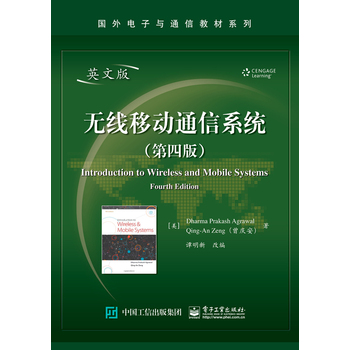无线移动通信系统(第四版)(英文版)
作 者:Dharma
出 版 社:电子工业出版社
丛 书:国外电子与通信教材系列
出版时间:2016年04月
定 价:89.00
I S B N :9787121285134
所属分类: 教育学习 > 教材 > 研究生/本科/专科教材 专业科技 > 计算机/网络 > 网络与数据通信
标 签:工学 教材 研究生/本科/专科教材
本书系统、全面地介绍了无线移动通信的基本理论,分析了无线移动通信所涉及的各个主题,包括无线移动信号的传输、蜂窝的基本概念、多路无线接入、多址技术、调制技术、信道分配技术、通信系统的设计、网络协议、现有的蜂窝系统、IEEE 802系列技术、Ad Hoc网络与传感器网络、无线网络的安全性与隐私问题、卫星通信系统等。为了加强对书中概念的理解,各章还给出了开拓思维的实验。
谭明新,博士,毕业于哈尔滨工程大学,现在华中师范大学信息技术系任教授。从事《现代交换技术》、《通信原理》、《信息论与编码》、《移动通信》、《数据通信》、《微波通信》等课程的教学工作。舰载数字程控交换系统国产化的技术骨干;主持国防科工委基金项目《turbo码在舰载通信系统中的应用研究》。
目 录CHAPTER 1 Introduction 11.1 History of Cellular Systems 11.2 Characteristics of Cellular Systems 121.3 Fundamentals of Cellular Systems 151.4 Cellular System Infrastructure 211.5 Network Protocols 241.6 IEEE 802.11 Technologies 241.7 Ad Hoc Networks 251.8 Sensor Networks 261.9 Wireless MANs, LANs, BANs, and PANs 271.10 Security and Privacy in Wireless Networks 281.11 Satellite Systems 281.12 Recent Advances 291.13 Outline of the Book 291.14 References 301.15 Problems 31Chapter 2 Mobile Radio Propagation 332.1 Introduction 332.2 Types of Radio Waves 332.3 Propagation Mechanisms 342.4 Free Space Propagation 352.5 Land Propagation 372.6 Path Loss 392.7 Slow Fading 412.8 Fast Fading 432.8.1 Statistical Characteristics of the Envelope 432.8.2 Characteristics of Instantaneous Amplitude 462.9 Doppler Effect 482.10 Delay Spread 502.11 Intersymbol Interference 512.12 Coherence Bandwidth 522.13 Cochannel Interference 522.14 Summary 532.15 References 532.16 Experiments 542.17 Open-Ended Projects 552.18 Problems 55Chapter 3 Cellular Concept 583.1 Introduction 583.2 Cell Area 583.3 Signal Strength and Cell Parameters 603.4 Capacity of a Cell 643.5 Frequency Reuse 663.6 How to Form a Cluster 673.7 Cochannel Interference 703.8 Cell Splitting 723.9 Cell Sectoring 723.10 Summary 753.11 References 753.12 Experiments 753.13 Open-Ended Projects 773.14 Problems 77Chapter 4 Multiple Radio Access 814.1 Introduction 814.2 Multiple Radio Access Protocols 824.3 Contention-Based Protocols 834.3.1 Pure ALOHA 844.3.2 Slotted ALOHA 854.3.3 CSMA 864.3.4 CSMA/CD 904.3.5 CSMA/CA 914.4 Comparison of CSMA/CD and CSMA/CA 954.5 Summary 954.6 References 954.7 Experiments 974.8 Open-Ended Projects 984.9 Problems 98Chapter 5 Multiple Division Techniques 1005.1 Introduction 1005.2 Concepts and Models for Multiple Divisions 1005.2.1 FDMA 1015.2.2 TDMA 1035.2.3 CDMA 1055.2.4 OFDM 1105.2.5 SDMA 1125.2.6 Comparison of Multiple Division Techniques 1135.3 Modulation Techniques 1145.3.1 Amplitude Modulation (AM) 1145.3.2 Frequency Modulation (FM) 1145.3.3 FSK 1165.3.4 Phase Shift Keying (PSK) 1165.3.5 Quadrature Phase Shift Keying (QPSK) 1175.3.6 π/4QPSK 1175.3.7 Quadrature Amplitude Modulation (QAM) 1195.3.8 16QAM 1195.4 Summary 1205.5 References 1215.6 Experiments 1215.7 Open-Ended Projects 1225.8 Problems 122Chapter 6 Channel Allocation 1256.1 Introduction 1256.2 Static Allocation versus Dynamic Allocation 1266.3 Fixed Channel Allocation (FCA) 1266.3.1 Simple Borrowing Schemes 1276.3.2 Complex Borrowing Schemes 1276.4 Dynamic Channel Allocation (DCA) 1306.4.1 Centralized Dynamic Channel Allocation Schemes 1306.4.2 Distributed Dynamic Channel Allocation Schemes 1316.5 Hybrid Channel Allocation (HCA) 1326.5.1 Hybrid Channel Allocation (HCA) Schemes 1326.5.2 Flexible Channel Allocation Schemes 1336.6 Allocation in Specialized System Structure 1336.6.1 Channel Allocation in One-Dimensional Systems 1336.6.2 Reuse Partitioning-Based Channel Allocation 1346.6.3 Overlapped Cells?CBased Channel Allocation 1356.7 System Modeling 1376.7.1 Basic Modeling 1376.7.2 Modeling for Channel Reservation 1396.8 Summary 1406.9 References 1416.10 Experiments 1416.11 Open-Ended Projects 1436.12 Problems 143Chapter 7 Mobile Communication Systems 1477.1 Introduction 1477.2 Cellular System Infrastructure 1477.3 Registration 1517.4 Handoff Parameters and Underlying Support 1537.4.1 Parameters Influencing Handoff 1537.4.2 Handoff Underlying Support 1547.5 Roaming Support 1567.5.1 Home Agents, Foreign Agents, and Mobile IP 1577.5.2 Rerouting in Backbone Routers 1597.6 Multicasting 1617.7 Ultra-Wideband Technology 1647.7.1 UWB System Characteristics 1647.7.2 UWB Signal Propagation 1657.7.3 Current Status and Applications of UWB Technology 1657.7.4 Difference between UWB and Spread Spectrum Techniques 1667.7.5 UWB Technology Advantages 1667.7.6 UWB Technology Drawbacks 1677.7.7 Challenges for UWB Technology 1677.7.8 Future Directions 1687.8 Femto Cell Network 1687.8.1 Technical Features 1687.8.2 Challenges 1717.9 Summary 1737.10 References 1737.11 Experiments 1757.12 Open-Ended Problem 1767.13 Problems 176Chapter 8 Network Protocols 1798.1 Introduction 1798.1.1 Layer 1: Physical Layer 1808.1.2 Layer 2: Data Link Layer 1818.1.3 Layer 3: Network Layer 1818.1.4 Layer 4: Transport Layer 1818.1.5 Layer 5: Session Layer 1818.1.6 Layer 6: Presentation Layer 1828.1.7 Layer 7: Application Layer 1828.2 TCP/IP Protocol 1828.2.1 Physical and Data Link Layers 1828.2.2 Network Layer 1838.2.3 TCP 1858.2.4 Application Layer 1858.2.5 Routing Using Bellman-Ford Algorithm 1858.3 TCP over Wireless 1868.3.1 Need for TCP over Wireless 1868.3.2 Limitations of Wired Version of TCP 1878.3.3 Solutions for Wireless Environment 1878.3.4 Link Layer Protocols 1898.4 Internet Protocol Version 6 (IPv6) 1908.4.1 Transition from IPv4 to IPv6 1908.4.2 IPv6 Header Format 1928.4.3 Features of IPv6 1928.4.4 Differences between IPv6 and IPv4 1938.5 Summary 1938.6 References 1938.7 Experiment 1958.8 Open-Ended Project 1958.9 Problems 196Chapter 9 Existing Wireless Systems 1989.1 Introduction 1989.2 AMPS 1989.2.1 Characteristics of AMPS 1999.2.2 Operation of AMPS 1999.2.3 General Working of AMPS Phone System 2029.3 IS-41 2039.3.1 Introduction 2039.3.2 Support Operations 2059.4 GSM 2059.4.1 Frequency Bands and Channels 2069.4.2 Frames in GSM 2089.4.3 Identity Numbers Used by a GSM System 2099.4.4 Interfaces, Planes, and Layers of GSM 2119.4.5 Handoff 2139.4.6 Short Message Service (SMS) 2149.5 IS-95 2149.5.1 Power Control 2179.6 IMT-2000 2199.6.1 International Spectrum Allocation 2209.6.2 Services Provided by Third-Generation Cellular Systems (3G) 2209.6.3 Harmonized Third-Generation Systems 2219.6.4 Multimedia Messaging Service (MMS) 2229.6.5 Universal Mobile Telecommunications System (UMTS) 2239.7 Summary 2279.8 References 2289.9 Problems 228Chapter 10 IEEE 802.11 Technologies and Access Points 23010.1 Introduction 23010.2 Downlink Transfer of Information 23110.3 Uplink Transfer of Information 23510.3.1 Uplink Transfer of Information with RTS/CTS 23510.4 Variants of 802.11 Series Protocols 23810.4.1 IEEE 802.11b 23910.4.2 IEEE 802.11g 24010.4.3 IEEE 802.11n 24010.4.4 IEEE 802.11ac 24110.5 WiFi Access in Airplanes 24310.6 Summary 24410.7 References 24410.8 Experiment 24510.9 Open-Ended Project 24510.10 Problems 245Chapter 11 Ad Hoc Networks 24711.1 Introduction 24711.2 Characteristics of MANETs 24911.3 Applications 25011.4 Routing 25111.4.1 Need for Routing 25111.4.2 Routing Classification 25211.5 Table-Driven Routing Protocols 25311.5.1 Destination-Sequenced Distance-Vector Routing 25311.5.2 Cluster Formation in a MANET 25411.5.3 Cluster Head Selection 25411.5.4 Cluster Head Gateway Switch Routing 25411.5.5 Wireless Routing Protocol 25611.6 Source-Initiated On-Demand Routing 25711.6.1 Ad Hoc On-Demand Distance Vector Routing 25711.6.2 Dynamic Source Routing 25811.6.3 Temporarily Ordered Routing Algorithm (TORA) 26011.6.4 Associativity-Based Routing 26211.6.5 Signal Stability-Based Routing 26311.7 Hybrid Protocols 26411.7.1 Zone Ro
